Family : Odobenidae

Text © DrSc Giuliano Russini – Biologist Zoologist

English translation by Mario Beltramini
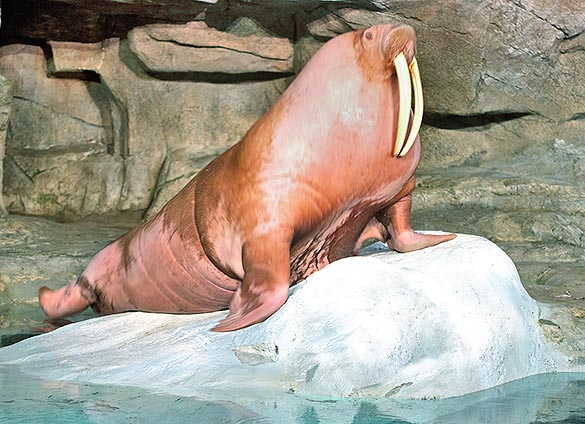
The Odobenus rosmarus reaches 4 m of length with 1400-1500 kg of weight © Giuseppe Mazza
The zoologists, however, ascribe them to a separated family in the superfamily of Pinnipeds (Pinnipedia), that of the Odobenids (Odobenidae), which include the only one genus Odobenus, differentiated, after some biologists in two species, after others in one species and two races, that is the Walrus (Odobenus rosmarus Linnaeus, 1759), treated in this text, and the races or subspecies of Atlantic walrus (Odobenus rosmarus rosmarus) and of Pacific walrus (Odobenus rosmarus divergens) ; the debate is still under way between the taxonomical biologists of the International Code for Zoological Nomenclature (ICZN).
Furthermore, we have to keep in mind that the genus Trichechus, indicates other big marine and estuarine mammals, such as the Manatees, for instance, the African manatee (Trichechus senegalensis) and the Dugongs of the order of the Sirenians (Sirenia) and of the family of the Trichechids (Trichechidae).
The Walrus (Odobenus rosmarus), is afferent therefore to the class of the Mammals (Mammalia), order Carnivores (Carnivora), suborder Caniforms (Caniformia, see the text Pinnipedia), superfamily Pinnipeds (Pinnipedia), family Odobenids (Odobenidae), genus Odobenus. The lemma “odeobenids” comes from the fusion of two words of the ancient Greek, odous “tooth” and baino “walk”, which literally means “to walk with the teeth”, this unusual name comes from the observations done by the first biologists who, in the XVIII-XIX centuries, met this enormous pinniped. They observed that a specimen for getting up from the water to a block of ice, utilized the long ivory tusks as they were an alpenstock, for anchoring and then moving upwards.
Zoogeography
The Walrus (Odobenus rosmarus), has been hunted for centuries for the ivory of the long tusks, even if not of high quality as that of the African tusks, for the bones, the flesh and the fat, from which they get an oil for several utilizations (an adult individual can furnish up to 250 kg of oil), has been subjected to slaughtering, done by the western man, to the point that it was almost close to the extinction; nowadays, this species and the two races in which it subdivides (present along the arctic and subarctic zones), is under the protection of the local Governments; it can be hunted only by the native Eskimo populations, which take from them only a few heads per year.
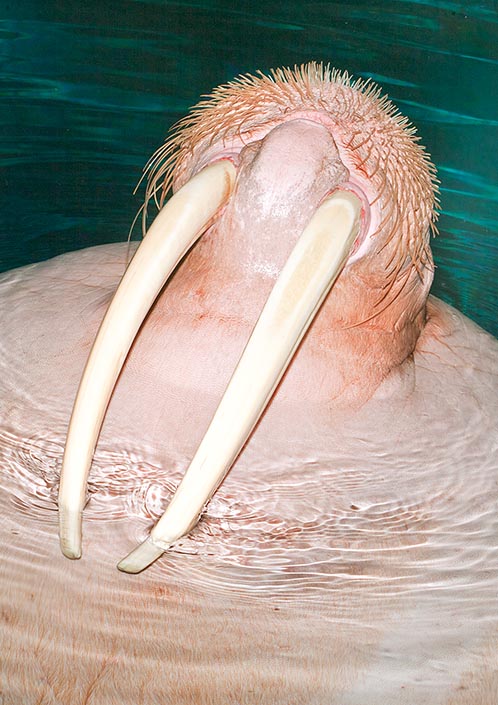
Tusks measure even 75 cm with 20 cm of diameter at the base © Giuseppe Mazza
At times, this odobenid goes much further south, so much that frequently small groups are observed also along the Norwegian coast and off Denmark and northern Holland.
The race Odobenus rosmarus rosmarus has the same geographic distribution of the good species, excepting that it is found also close to the mouth of the Yenisei River, in Novaya Zemlya.
The Pacific walrus (Odobenus rosmarus divergens), which differs from the Atlantic one because having more pronounced mystacial vibrissae, less regular head, nostril placed more upwards, lives preferentially along the north-eastern coasts of Asia and the north-western ones of America.
The good species, as well as both races and subspecies, move southward in autumn; the Pacific one passes through the Bering Strait before the forming ices block it.
Ecology-Habitat
The walrus carries on an amphibian life; when the Arctic region was still crowded by walruses and the immense aggregations were formed by countless families, a walrus had to swim quite a lot for reaching the mainland.
The biologists have always wondered why this animal did engage in such marine marathons with relevant dangers. Perhaps, it sleeps better on the solid ground, taking advantage from some sunbath and because when in water it has, every ten minutes, to push out the nose for stocking up on fresh air; but this contrasts with the fact that, contrary to the puppies of the seals, the walrus’ ones come to life among the sea waves and perhaps, after some eminent biologists, also the mating, not yet completely clarified, should be a “bathing” coupling.
The habitat of the walrus is formed by the mainland as well as the water. When ashore, this giant does not have elegant movements, it can move the body, a real mountain of fat, only by wiggling the hips and the fins, with the belly creeping the ground; but, once started, it has stunning performances. It can climb icebergs even of medium height. Especially the fore fins are those pulling away the enormous body, whilst the hind ones do the pushing. The life in water is necessary for hunting the molluscs, the crustaceans, the squids and the fishes it eats (herrings, in particular), which it finds, having a poor eyesight, by means of the vibrissae of the whiskers, but there is a special time, lasting about six weeks and starting in November, where it unwillingly dives into the liquid element, and this is that of the “moulting”. During this period, the animal is very nervous and the diving into the water, for instance, for eating, probably is much painful; furthermore its crustiness in this period, often s origin of scuffles with the neighbours, at times even much violent.
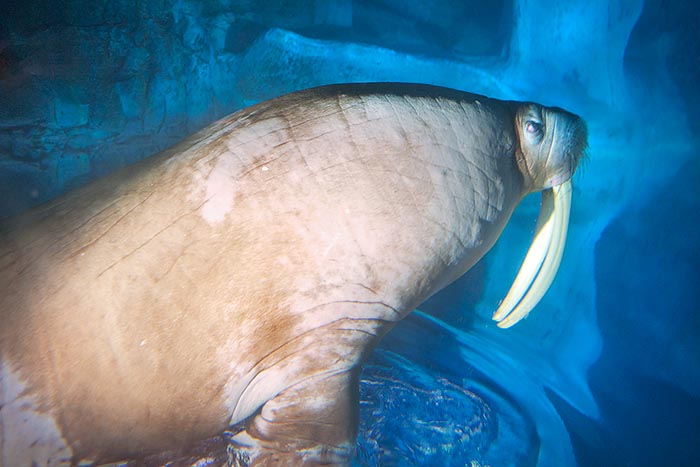
A submerged walrus. The head is quite small compared to the body © Giuseppe Mazza
Morpho-physiology
As aforementioned, the walruses are placental, pinniped mammals, which, like the seals, do not have the pinna, whilst they share with the sea lions the capacity to flex the limbs under the body. Of massive and imposing look, they may reach the 4 m of length, and a weight of 1.400-1.500 kg. However, like the other pinnipeds, due to the hydro-dynamic shape of the body, the limbs transformed in fins and the thick adipose tissue, they are proficient swimmers.
As briefly said before, the moulting begins in November and lasts six weeks, the body of the walrus is covered by a strong, wrinkled and violaceous skin, with short and sparse hairs, these fall during the winter months and grow again in March. On the contrary, the newborn, are protected by a soft and thick mantle which, while growing, becomes more and more thin. The head of the walrus is relatively small, round with a short muzzle adorned with long whiskers, or vibrissae, formed by long bristles. These are evident in the juveniles, whilst as the years go, the wear out, due to the continuous friction they are submitted while looking for food on the bottoms.
Very much characteristic is the dentition, formed by 18-20 teeth, which during the growth they are submitted to reductive phenomena but the upper canines, which, being rootless, go on in growing for the whole life which, in the walrus can last even 30 years. Thus, the oldest specimens have even 75 cm long tusks, 20 cm broad at the base and weighing 3 kg.
These tusks are present in the males and also in the females, in the last ones they are slightly thinner and little shorter, apart the body size in favour to the males, there are no characters of sexual dimorphism. The tusks are used not only for climbing ashore, but also for digging or ploughing the muddy-sandy bottom, looking for molluscs and crustaceans.
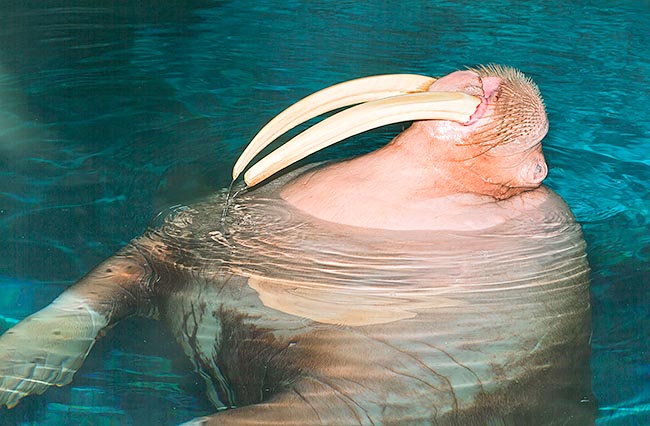
With the tusks it ploughs the bottom and with the vibrisse it finds crustaceans and molluscs © Giuseppe Mazza
It is interesting to note that the utilization of the vibrissae as antennas seeking food, ensures that, in the free animal, they are well cared and shorter than those of the specimens living in captivity; as a matter of fact, in the walruses present in the zoological gardens, in the aquatic parks and in the aquaria, the vibrissae grow more quickly and are longer, as on the cement of the bottom of the pool where they stand, there is little to look for; in order to allow these Arctic giants to exercise, the biologists and the keepers, every day, drop n the artificial basins hundredweights of molluscs, crabs, fishes and weeds.
Ethology-Reproductive Biology
On the mainland, these animals need the physical contact, and for this reason they pile up on each other for resting; occasionally some undesired subject, which dives in the middle disturbing the neighbours, triggers brawls which, as a chain reaction, involve tens and tens of individuals, till each one has not been able to recover its own room where to rest.
Quarrels happen and are much violent also during the mating season for the conquest of the females. In both cases, the animals, which have numerous scars, done also by many parasites, get wounded very deeply with the tusks and tens of them can be seen bleeding.
We have to say that this tendency to laziness, associated with the fact of living all together and to the clumsiness in the movements has, since ever, helped the hunters, who approaching slowly, can shoot like hell or harpoon the poor pinnipeds killing many of them. But the walrus can get revenged against the man in water, where it can capsize a boat with its crew in the gelid arctic waters or, in the case of a mother with the young, which she will defend to the death, crushing the cowardly hunter on the mainland.
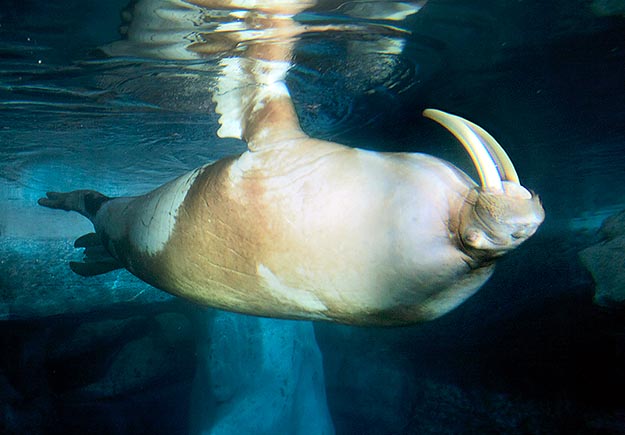
Clumsy on land, is very agile in sea, where it swims even belly up © Giuseppe Mazza
If a mother passes away, the young orphan is immediately adopted by the other females of the group.
On the mainland, besides the human being, only the Polar bear (Ursus maritimus) is capable to kill an old or sick specimen, as a walrus in its prime hardly has the worst, whilst, in water, but always quite painfully, the only animal able to kill it is the Orca (Orcinus orca), even if this delphinid prefers hunting the sub-adults or the young instead of the adults.
A male walrus has a minimum of three females up to a ten and with them it forms its family; several small families join in tribes and all together belong to the group.
The male is a conscientious householder who always keeps an eye on its tribe. When the members of this one go to the sea, it waits till when the last member enters the waves before entering them in its turn. But takes into account also the will of the female and in fact, if a move is necessary, it’s the female making the choice.
The female, on the other hand, does not worry too much for the male; all his cares are for the puppy. Any unwelcome, even a young, is driven with its tusks. The puppies, after a gestation of 15-16 months, come to life in April and May and are suckled by the mother for a year and a half; the milk has a 40% of fats, and is necessary for furnishing the puppy an energetic input, remarkable in such hostile environment.
Also here (see text Pinnipedia), the embryos at the stage of morula-blastocysts, can be subject to phenomena of diapause or suspended animation. The females have two heats, and so they are called polyestrous; they get in oestrus once in February and once by the end of the summer, but since the males get in heat only in February, the other oestrus is, so to speak, void. Most probably the matings take place in water, between January and March of the year preceding the delivery. Till now, the IUCN has not yet, due to lack of data, established a status for this species.
→For general information about PINNIPEDIA please click here
